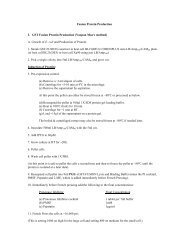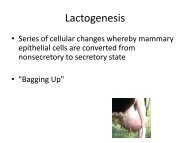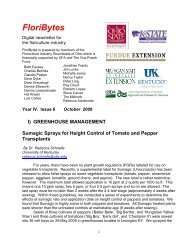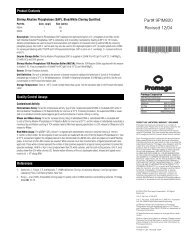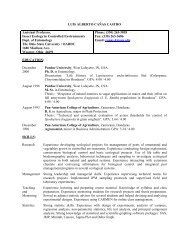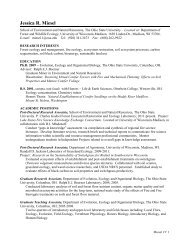Evaluating the Effectiveness of Compost Bedded Dairy Pack - Ohio ...
Evaluating the Effectiveness of Compost Bedded Dairy Pack - Ohio ...
Evaluating the Effectiveness of Compost Bedded Dairy Pack - Ohio ...
Create successful ePaper yourself
Turn your PDF publications into a flip-book with our unique Google optimized e-Paper software.
<strong>Evaluating</strong> <strong>the</strong> <strong>Effectiveness</strong><br />
<strong>of</strong> <strong>Compost</strong> <strong>Bedded</strong> <strong>Dairy</strong><br />
<strong>Pack</strong> Systems for <strong>Ohio</strong><br />
Dr. Lingying Zhao<br />
Dr. Harold Keener<br />
Mary Wicks<br />
Dr. Michael Brugger<br />
Shunli Wang<br />
Jon Rausch<br />
Amanda Meddles<br />
Mike Klingman<br />
Roderick Manuzon<br />
Dr. Jeetendra Upadhyay<br />
Department <strong>of</strong> Food, Agriculture and<br />
Biological Engineering<br />
The <strong>Ohio</strong> State University
Overview<br />
• Introduction <strong>of</strong> <strong>the</strong> study<br />
• Study methods<br />
• Indoor environment and air quality<br />
in bedded pack dairy facility<br />
• Characteristics <strong>of</strong> <strong>the</strong> compost<br />
bedded back<br />
• Conclusions<br />
• Recommendations
Background <strong>of</strong> <strong>the</strong> Study<br />
• <strong>Ohio</strong> dairy industry contributed $862 million<br />
to <strong>the</strong> <strong>Ohio</strong> economy through milk and o<strong>the</strong>r<br />
dairy product sales in 2007.<br />
• 58% <strong>of</strong> dairy farms use liquid manure storage.<br />
• Liquid manure systems require careful<br />
management to minimize <strong>the</strong> risks <strong>of</strong> manure<br />
run<strong>of</strong>f and can have high costs associated with<br />
transport <strong>of</strong> a material that is up to 90%
Background <strong>of</strong> <strong>the</strong> Study<br />
• For dairy farms to remain economically viable,<br />
production systems that improve <strong>the</strong> health <strong>of</strong><br />
<strong>the</strong> cow, minimize manure handling costs, and<br />
reduce potential environmental impacts are<br />
needed.<br />
• An alternative system that has been evaluated<br />
by <strong>the</strong> University <strong>of</strong> Minnesota (UMN) over<br />
<strong>the</strong> last several years is <strong>the</strong> compost bedded<br />
pack dairy barn.
<strong>Compost</strong> bedded pack system<br />
Characteristics:<br />
• loose housing<br />
• 3-4 ft bedding<br />
• mechanical stirring<br />
Benefits:<br />
• cow comfort<br />
• cow health<br />
• easy to manage
Background <strong>of</strong> <strong>the</strong> Study<br />
• The potential positive impacts for milk<br />
production as well as <strong>the</strong> ability to handle<br />
manure as a dry material have resulted in<br />
increased interest in bedded pack systems in<br />
<strong>Ohio</strong> .<br />
• Scientific study to evaluate <strong>the</strong> bedded pack<br />
system design in <strong>Ohio</strong> is requested by NRCS.
Objectives<br />
• Analyze UMN recommendations to determine<br />
if <strong>the</strong>y meet animal needs and can be applied<br />
in <strong>Ohio</strong>’s climate.<br />
• Evaluate compost bedded pack systems in<br />
<strong>Ohio</strong> to document current practices and<br />
assess <strong>the</strong>ir effectiveness.<br />
• Develop recommended design and<br />
management guidelines for dairy bedded<br />
pack systems.
Methodology<br />
• 4 study farms, 4 visits, 1 in each season<br />
• Air quality (6-10 locations, before/after stirring)<br />
– T and RH<br />
– Carbon dioxide (CO 2)<br />
– Hydrogen sulfide (H 2S)<br />
– Ammonia (NH 3)<br />
• <strong>Bedded</strong> pack (6 random locations, 6-, 12-, 18-inch<br />
depths)<br />
– Temperature & oxygen<br />
– Total-N, ammonia-N, moisture, ash, carbon, pH
Barn D-1, Zanesville, OH<br />
• <strong>Compost</strong> barn began operations May 2006<br />
• 160-170 heifers<br />
• Cow spacing: 75 sq ft/cow<br />
• <strong>Bedded</strong> area adjacent to feed alley
Barn D-2, Millersburg, OH<br />
• <strong>Compost</strong> barn began operations Jan. 2008<br />
• 150-160 Jerseys (on pasture spring-fall)<br />
• Cow spacing: 88 sq ft/cow<br />
• Feed alley and manure storage at <strong>the</strong> end <strong>of</strong><br />
building
Barn D-3, Lodi, OH<br />
• <strong>Compost</strong> barn began operations Nov. 2008<br />
• 60-65 Holsteins<br />
• Cow spacing: 90 sq ft/cow
Barn D-4, Mantua, OH<br />
• <strong>Compost</strong> barn began operations Dec. 2007<br />
• 80-90 Holsteins-Jersey & Holstein-Jersey-<br />
Normandy crosses (on pasture spring-fall)<br />
• Cow spacing: 80 sq ft/cow
Analysis <strong>of</strong> Design and Management<br />
Practices in Reference <strong>of</strong> MN<br />
Recommendation<br />
Practice Recommend Farm D-1 Farm D-2 Farm D-3 Farm D-4<br />
Cow spacing (sq ft) 65-80 75 88 90 80<br />
Concrete wall (ft) 4 4 4 4 3<br />
Sidewall height (ft) 16 16 16 16 14<br />
Bedding type sawdust sawdust sawdust + straw 1 sawdust sawdust + straw 2<br />
Bedding depth (in) 4<br />
12-48 12-48 12-48 12-48 12-36<br />
Bedding additions as needed as needed as needed as needed as needed<br />
Stirring frequency 2 times/day 2 times/day 2 times/day 3<br />
2 times/day 2 times/day 3<br />
Feed alley scrape 2x/day scrape 2x/day scrape 2x/day 3<br />
scrape 2x/day scrape 2x/day 3<br />
<strong>Pack</strong> clean out 6-12 months 12+ months 5<br />
12 months 12 months 9 months
Design and Management in OH<br />
Use Minnesota guidelines with a few variations:<br />
• D2. Mid-Feb to early May, unable to obtain<br />
sawdust so used straw and did not turn.<br />
• D4. Feb to early March, limited sawdust so<br />
alternated with sliced straw and continued to<br />
turn.<br />
• D2 and D4. Reduce frequency <strong>of</strong> sawdust<br />
additions, pack turning and feed alley scraping<br />
when cows on pasture.
Sampling Plan for Barn D-1<br />
• 4 points for<br />
continuous T and RH<br />
measurement<br />
• 5 points for gas<br />
concentration<br />
• 3 points for<br />
verification <strong>of</strong> gas<br />
concentration<br />
• 6 random points for<br />
compost bedding<br />
sampling
Sampling Plan for Barn D-2<br />
• 4 points for<br />
continuous T and RH<br />
measurement<br />
• 5 points for gas<br />
concentration<br />
• 3 points for<br />
verification <strong>of</strong> gas<br />
concentration<br />
• 6 random points for<br />
compost bedding<br />
sampling
Sampling Plan<br />
for Barn D-3
Sampling Plan<br />
for Barn D-4
Indoor environment<br />
measurement<br />
• Air velocity– TSI VELOCICALC®<br />
– 0-9999 fpm<br />
– 3% error<br />
• Temperature- TSI VELOCICALC®<br />
– Range: 0 to 60 C (32 to 140 F)<br />
– Accuracy: 0.6 C ( 1.0 F)<br />
– Resolution: 0.1 C (0.1 F)<br />
• Humidity- TSI VELOCICALC®<br />
– Range: 5% to 95% RH<br />
– Accuracy: 2.0% RH<br />
– Resolution: 0.1% RH<br />
• Hobo Outdoor Air Sensors<br />
• Range <strong>of</strong> -35°C to 80°C<br />
• and 0 to 100% RH
CO 2 measurement<br />
• TSI-IAQ meter:<br />
– 0-5000 ppm<br />
– 50 ppm or 3% <strong>of</strong> reading<br />
– Resolution:1 ppm<br />
• Ma<strong>the</strong>son-tri-gas<br />
Kitagawa tubes<br />
– Accuracy: 5 to 15%
Ammonia (NH 3) measurement<br />
• SPM:<br />
– Range: 0-30 ppm<br />
– Resolution: 0.5 ppm<br />
• Ma<strong>the</strong>son-tri-gas<br />
Kitagawa tubes<br />
– Accuracy: 5 to 15%
Hydrogen sulfide (H 2S)<br />
• Jerome H2S<br />
analyzer 631-X<br />
– Range: 0.001 to 50 ppm<br />
– Resolution: 0.003 ppm<br />
– Accuracy:<br />
0.003 ppm at 0.05 ppm<br />
0.03 ppm at 0.5 ppm<br />
0.3 ppm at 5 ppm<br />
2 ppm at 25 ppm<br />
• Ma<strong>the</strong>son-tri-gas<br />
Kitagawa tubes<br />
– Accuracy: 5 to 15%<br />
measurement
•<br />
OT-21 Temperature and O 2 Probe<br />
• Oxygen<br />
measurement<br />
range is 0-22%<br />
• Temperature<br />
range is -18 ºC<br />
- +100 ºC<br />
for <strong>Bedded</strong> <strong>Pack</strong>
Temperature(oC)<br />
30<br />
25<br />
20<br />
15<br />
10<br />
5<br />
0<br />
-5<br />
-10<br />
Temperatures in <strong>the</strong> Barns<br />
Winter Spring Summer Autumn<br />
Seasons<br />
D1<br />
D2<br />
D3<br />
D4<br />
˚F ˚C<br />
79 26.1<br />
77 25.0<br />
75 23.9<br />
73 22.8<br />
71 21.7<br />
69 20.6<br />
67 19.4<br />
65 18.3<br />
63 17.2<br />
61 16.1<br />
59 15.0<br />
57 13.9<br />
55 12.8<br />
53 11.7<br />
51 10.6<br />
49 9.4<br />
47 8.3<br />
45 7.2
Relative Humidity (RH) in <strong>the</strong> Barns<br />
RH (%)<br />
100<br />
90<br />
80<br />
70<br />
60<br />
50<br />
40<br />
30<br />
20<br />
10<br />
0<br />
Winter Spring Summer Autumn<br />
Seasons<br />
D1<br />
D2<br />
D3<br />
D4
Air Velocity (m/s)<br />
2<br />
1.8<br />
1.6<br />
1.4<br />
1.2<br />
1<br />
0.8<br />
0.6<br />
0.4<br />
0.2<br />
0<br />
Air Velocity in <strong>the</strong> Barns<br />
Winter Spring Summer Autumn<br />
Seasons<br />
D1<br />
D2<br />
D3<br />
D4
Thermal Environment in <strong>the</strong> Barns<br />
VARIABLE<br />
Temperature (mean)<br />
MEASUREME<br />
NT<br />
28 – 78 F<br />
(-2-26 C)<br />
Cow Comfort<br />
Zone<br />
40-60 F<br />
(4-16 C)<br />
Relative humidity (mean) 35 – 90% 30-70%<br />
Air velocity (mean) 0.2 – 1.8 m/s n/a<br />
• Temperatures in naturally ventilated dairy<br />
barns follow wea<strong>the</strong>r changes<br />
• In cold winter, <strong>the</strong> barn temperature is below<br />
<strong>the</strong> cow comfort zone<br />
• In hot summer, <strong>the</strong> temperature is above <strong>the</strong><br />
cow comfort zone, cooling fans are needed.
NH 3 Concentrations in <strong>the</strong> Barns<br />
NH3 Concentration (ppm)<br />
1.8<br />
1.6<br />
1.4<br />
1.2<br />
1<br />
0.8<br />
0.6<br />
0.4<br />
0.2<br />
0<br />
Winter Spring Summer Autumn<br />
Seasons<br />
D1<br />
D2<br />
D3<br />
D4
H 2S Concentrations in <strong>the</strong> Barns<br />
H2S Concentration (ppb)<br />
14<br />
12<br />
10<br />
8<br />
6<br />
4<br />
2<br />
0<br />
Winter Spring Summer Autumn<br />
Seasons<br />
D1 D2<br />
D3 D4
CO2 Concentration (ppm)<br />
CO 2 Concentrations in <strong>the</strong> Barns<br />
1200<br />
1000<br />
800<br />
600<br />
400<br />
200<br />
0<br />
D1 D2 D3 D4<br />
Winter Spring Summer Autumn<br />
Seasons
NH3 Concentration (ppmv)<br />
6<br />
5<br />
4<br />
3<br />
2<br />
1<br />
0<br />
Diurnal variation <strong>of</strong> NH 3 and CO 2<br />
Concentrations in <strong>the</strong> Barns<br />
ppm,<br />
NH3<br />
ppm, CO2<br />
5/7 5/8 5/9 5/10 5/11 5/12<br />
1000<br />
900<br />
800<br />
700<br />
600<br />
500<br />
400<br />
CO2 Concentration (ppmv)
Summary <strong>of</strong> Air Quality in <strong>the</strong> Barns<br />
VARIABLE MEASUREMENT OSHA<br />
Carbon dioxide 400 – 700 ppm 5000 ppm<br />
Ammonia 0 – 1.6 ppm 50 ppm<br />
Hydrogen sulfide 1 – 12 ppb 20 ppm<br />
• No air quality concerns.<br />
• Ventilation is adequate for cow health.
Characteristics <strong>of</strong> <strong>Bedded</strong> <strong>Pack</strong><br />
VARIABLE MEASUREMENT<br />
Temperature 90 – 120 F<br />
Oxygen 7 – 9 %<br />
C/N ratio 9-36<br />
ash 9.6 – 52.0<br />
pH 7 - 9<br />
N-P-K 1.8-3.3 (N); ~1 (P 2O 5); 2-3 (K 2O)<br />
• T, oxygen, pH indicate composting conditions.<br />
• High variability <strong>of</strong> C/N and ash due to continuous<br />
additions <strong>of</strong> feces and urine.<br />
• Assuming a 2.5:1:2 N:P:K content and 65% moisture ,<br />
each ton <strong>of</strong> wet pack would supply 17.5, 7 and 14 lbs<br />
<strong>of</strong> N, P 2O 5, and K 2O, respectively.
Cow Health & Comfort<br />
• Somatic cell counts averaged between<br />
144,000 – 188,000.<br />
• Farmer satisfied with system, with<br />
reports including:<br />
– improved milk quality and production,<br />
– improved feet health (reduced hairy wart),<br />
– cleanliness <strong>of</strong> cows,<br />
– ease <strong>of</strong> management.
Conclusions<br />
• The compost bedded pack dairy barns in <strong>Ohio</strong><br />
followed <strong>the</strong> general recommendations from<br />
Minnesota.<br />
• The air quality in <strong>the</strong> barns was very good.<br />
• As a nature <strong>of</strong> natural ventilation, <strong>the</strong> indoor<br />
environment are out <strong>of</strong> <strong>the</strong> cow comfort zone<br />
in Winter and Summer.<br />
• The cow health and performance was very<br />
good.
Conclusions<br />
• There was good composting action when <strong>the</strong><br />
bedded pack was stirred as recommended.<br />
• This study confirmed that <strong>the</strong> design guidelines<br />
for composted bedded pack barns from<br />
Minnesota would work well in <strong>Ohio</strong>.<br />
• There is a need for having a reliable source <strong>of</strong><br />
sawdust, as <strong>the</strong>re have not been many good<br />
alternatives identified that work well in <strong>the</strong><br />
compost bedded pack barns.
Recommendations for <strong>Ohio</strong><br />
Barn design<br />
• Spacing: 65-90 sq/ft/cow (900 – 1,400 lbs)<br />
• Concrete wall: 3-4 ft to hold 6-12 months<br />
accumulation <strong>of</strong> bedding and manure<br />
• Feed alley: concrete, 12-ft wide, separated<br />
from pack (ideally)<br />
• Waterers: in feed alley along concrete wall<br />
• Ventilation: 14-16 ft side curtain; openings on<br />
short sides; overhead fans
Recommendations for <strong>Ohio</strong><br />
Bedding management<br />
• Type: fine dry sawdust; if supplement with<br />
straw, chop & alternate with sawdust<br />
• Depth: initial depth 12-18; include bedding<br />
from clean out to inoculate for composting;<br />
clean out when reach wall height (~12 months)<br />
• Additions: add 1-2 in when bedding sticks to<br />
cow after lying down (~10-14 days)<br />
• Stirring: 2x/day to depth <strong>of</strong> 10-12 in.
Recommendations for <strong>Ohio</strong><br />
Manure management<br />
• Feed alley: scrape 2x/day; separate storage<br />
• <strong>Pack</strong>: remove every 6-12 months depending<br />
on depth and condition (e.g., moisture)
Recommendations for <strong>Ohio</strong><br />
O<strong>the</strong>r considerations<br />
• Pasture: adjust frequency <strong>of</strong> stirring, bedding<br />
additions and alley scraping<br />
• Land application: land apply pack; if C/N ratio<br />
exceeds 30:1, may tie up nitrogen
Acknowledgements<br />
Funding:<br />
• USDA-NRCS<br />
• <strong>Ohio</strong> <strong>Dairy</strong> Research Fund<br />
Thank you to <strong>the</strong> participating<br />
farms.
Questions?



